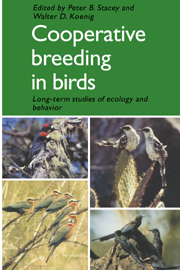Book contents
- Frontmatter
- Contents
- Contributors
- Introduction
- 1 Splendid Fairy-wrens: demonstrating the importance of longevity
- 2 Green Woodhoopoes: life history traits and sociality
- 3 Red-cockaded Woodpeckers: a ‘primitive’ cooperative breeder
- 4 Arabian Babblers: the quest for social status in a cooperative breeder
- 5 Hoatzins: cooperative breeding in a folivorous neotropical bird
- 6 Campylorhynchus wrens: the ecology of delayed dispersal and cooperation in the Venezuelan savanna
- 7 Pinyon Jays: making the best of a bad situation by helping
- 8 Florida Scrub Jays: a synopsis after 18 years of study
- 9 Mexican Jays: uncooperative breeding
- 10 Galápagos mockingbirds: territorial cooperative breeding in a climatically variable environment
- 11 Groove-billed Anis: joint-nesting in a tropical cuckoo
- 12 Galápagos and Harris' Hawks: divergent causes of sociality in two raptors
- 13 Pukeko: different approaches and some different answers
- 14 Acorn Woodpeckers: group-living and food storage under contrasting ecological conditions
- 15 Dunnocks: cooperation and conflict among males and females in a variable mating system
- 16 White-fronted Bee-eaters: helping in a colonially nesting species
- 17 Pied Kingfishers: ecological causes and reproductive consequences of cooperative breeding
- 18 Noisy Miners: variations on the theme of communality
- Summary
- Index
12 - Galápagos and Harris' Hawks: divergent causes of sociality in two raptors
Published online by Cambridge University Press: 07 September 2010
- Frontmatter
- Contents
- Contributors
- Introduction
- 1 Splendid Fairy-wrens: demonstrating the importance of longevity
- 2 Green Woodhoopoes: life history traits and sociality
- 3 Red-cockaded Woodpeckers: a ‘primitive’ cooperative breeder
- 4 Arabian Babblers: the quest for social status in a cooperative breeder
- 5 Hoatzins: cooperative breeding in a folivorous neotropical bird
- 6 Campylorhynchus wrens: the ecology of delayed dispersal and cooperation in the Venezuelan savanna
- 7 Pinyon Jays: making the best of a bad situation by helping
- 8 Florida Scrub Jays: a synopsis after 18 years of study
- 9 Mexican Jays: uncooperative breeding
- 10 Galápagos mockingbirds: territorial cooperative breeding in a climatically variable environment
- 11 Groove-billed Anis: joint-nesting in a tropical cuckoo
- 12 Galápagos and Harris' Hawks: divergent causes of sociality in two raptors
- 13 Pukeko: different approaches and some different answers
- 14 Acorn Woodpeckers: group-living and food storage under contrasting ecological conditions
- 15 Dunnocks: cooperation and conflict among males and females in a variable mating system
- 16 White-fronted Bee-eaters: helping in a colonially nesting species
- 17 Pied Kingfishers: ecological causes and reproductive consequences of cooperative breeding
- 18 Noisy Miners: variations on the theme of communality
- Summary
- Index
Summary
Hawks (Order Falconiformes) and owls (Order Strigiformes) are long-lived, territorial, and often show delayed maturation, traits common in cooperative breeders. Yet, of over 250 species of hawks and nearly 140 species of owls, fewer than a dozen species possess some form of group breeding. This low level of sociality may reflect characteristics of food limitation or aggressiveness distinctive to raptors (see below), or it may indicate our limited knowledge of reproductive behavior in this group. In particular, little is known about the nesting behavior of tropical raptors, yet it is there that one might expect cooperative breeding to occur. The observation that a third of the known group-breeding hawks are tropical or subtropical in occurrence suggests strongly that generalizations about raptor sociality should be made carefully.
Those hawks where more than two breeders have been recorded at a nest generally fit into three categories:
Unusual, probably aberrant threesomes that occur in typically monogamous species, as occurs rarely in the Red-tailed Hawk (Buteo jamaicensis: Santana et al. 1986).
Helper-at-the-nest systems typified by the regular occurrence of juvenile or young-adult helpers, as occurs in the Mississippi Kite (Ictinia mississippiensis; Parker and Ports 1982) and Merlin (Falco columbarius; James and Oliphant 1986).
Multiple-adult breeding groups that are maintained between breeding attempts.
In this paper, we focus our attention on two members of the latter categories, the Galápagos Hawk (Buteo galapagoensis), which apparently mates polyandrously, and Harris' Hawk (Parabuteo unicinctus), which may have helpers at the nest and multiple-adult breeding groups.
- Type
- Chapter
- Information
- Cooperative Breeding in BirdsLong Term Studies of Ecology and Behaviour, pp. 357 - 384Publisher: Cambridge University PressPrint publication year: 1990
- 24
- Cited by

